Field trips are an opportunity to observe, study, and collect rocks, minerals, and fossils in nature. Dr. Schulmeister, from the Earth Science Department at Emporia State University, organized a field trip in October 2005 for ES 333 Environmental Geology students and other interested faculty. While the overall theme of this field trip was the economic use of the salt beds in the mid-continent, the trip included a stop at a sedimentary rock outcrop; the Enterprise Products Operating L.P., a dissolution salt cavern gas storage facility; and the Carey Salt Mine and Underground Vaults and Storage, an active salt mine-underground storage facility. This webpage focuses on the underground mining of rock salt and the subsequent use of the empty halite rooms created by mining.
Carey Salt Mine and the Underground Vaults and Storage, Inc. are in fact located on the same site in Hutchinson, Reno County, Kansas. A room-and-pillar mining technique used to extract rock salt created caverns that were converted in 1959 to a records storage facility located 650 feet underground (Underground Vaults & Storage, Inc.). Limited access to the mine creates a secure storage facility. Also, underground caverns maintain a stable temperature and humidity in which to archive everything from documents to films.
According to the Carey Salt brochure, this salt deposit is "one of the largest deposits known in the world," 4000 square miles in area, covering parts of Kansas, Oklahoma, and Texas. In the Hutchinson area, the salt layer is 600 feet deep and 325 feet thick, and was discovered in 1887 by Ben Blanchard who was drilling for oil (Underground Vaults and Storage, n.d.). Emerson Carey began working in salt mining in 1901 and production of salt by the Carey company began in 1923 (Lee Spence, personal communication, October 28, 2005). The mining operation was dedicated at that time, and President Warren Harding and Kansas Governor John Davis were in attendance (Carey Salt).
This mine facility extracts rock salt by excavation with heavy equipment. The Carey company has 38 salt products that are shipped all over the U.S. (Carey Salt, n.d.). Lee Spence, President of Underground Vaults and Storage, Inc., guided the tour and provided information on the mine and storage facility. The images below tell the story of our tour.
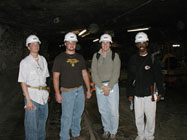
Photo date 10/05, © Photo courtesy of Marcia Schulmeister Photo taken by S.W. Aber. |
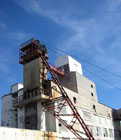
Photo date 10/05, © S.W. Aber. |
|
The ES333 Environmental Geology class is shown above on the left, while all participants are shown above on the right ready to board the elevator for a tour of an active rock salt mine and underground storage facility. This picture, taken by a Carey Salt miner, demonstrates the fine cloud of salt dust, as white circles on the image. For mining safety, each person was issued a hard hat, breathing apparatus, and safety glasses. Also, each visitor is assigned a numbered brass tag, which was placed outside the elevator, above ground, to indicate who was currently below ground. The elevator, called a skip, uses cables operated by an electric winch in the hoist house, which is seen in the center image. The rock salt is hoisted up to the Breaker House where it is crushed further and screened into a variety of sizes for different end purposes. Participants shown in the image from left to right include: Lee Spence; Tyler Ringler, an Earth Science student; Paul Johnston, Professor Emeritus who taught and created the ESU Johnston Geology Museum; John Waechter, an Earth Science student; Kevin Barnett, an Earth Science graduate student; Elena Volkova, a Russian Fulbright scholar in residence at the Earth Science Department at ESU; Marcia Schulmeister, Assistant Professor; and Susie Aber, Lecturer. |
||
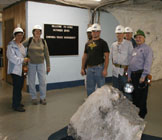
Photo date 10/05, © Photo courtesy of Marcia Schulmeister Photo taken by Elena Volkova. |
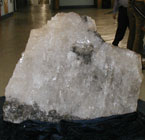
Photo date 10/05, © Photo courtesy of Marcia Schulmeister. |
|
We were greeted with a welcome sign 650 feet below the surface! These images show the Hutchinson Salt Member from the Wellington Formation, Upper Permian. The salt is bedded and while relatively pure NaCl occurs in some areas, it is rock salt in other areas. The image to the right shows the halite interbedded with darker layers of shale and anhydrite, not a biotite gneiss as it might appear. |
||
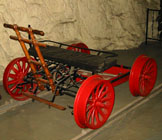
Photo date 10/05, © S.W. Aber. |
||
Lee Spence (above left) led the group on a tour of the working mine and storage facility. Lee described that of the 450,000 tons of rock salt mined each year, with 80% used for road deicing and 20% used for cattle supplements. None of this rock salt is used as table salt. While the salt layer is located at 600 feet below the surface, this salt layer dips and to the north it is 1000 to 1200 feet deep at the Lyons and Kanopolis, mines north of Hutchinson areas. We are standing among mining equipment artifacts that will be housed in the museum, which should open by 6/2006. |
||
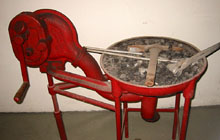
Photo date 10/05, © S.W. Aber. |
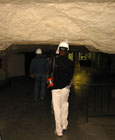
Photo date 10/05, © S.W. Aber. |
|
|
We began the tour in an earlier mined out area and Lee is pointing out that this low ceiling was preserved (above center). Also, in some areas of the mine, the walls and ceiling were painted to lighten up the area. The active mining is two miles from the current elevator shaft and the Carey Company has 67 miles covering 900 acres (Lee Spence, personal communication, October 28, 2005). | ||
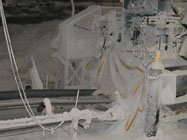
Photo date 10/05, © Photo courtesy of Marcia Schulmeister. |
While salt was moved in the past by cart and donkey, today the crushed product moves along corridors on a conveyor belt (right). Explosives and heavy equipment are used to free the rock salt that is then moved through three crushing units underground (left) and transported to the skip for the trip to the surface. The skip can hold four tons of crushed rock salt and make the round trip from mine to surface in three minutes (Carey Salt). |

Photo date 10/05, © S.W. Aber. |
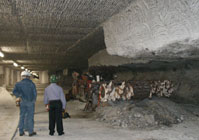
Photo date 10/05, © Photo courtesy of Marcia Schulmeister. |
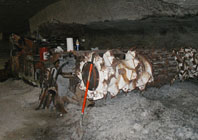
Photo date 10/05, © Photo courtesy of Marcia Schulmeister. |
|
This electrically-powered machine (above left and center) was once used in coal mining and serves to grind the rock salt from walls and ceilings creating a squared off effect for walls and ceilings of the cavern. Characteristic markings result with interesting patterns from the blade (above right). The darker parts of the wall are natural and although rock salt is 95% halite, it contains shale and other impurities. |
||
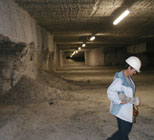
Photo date 10/05, © Photo courtesy of Marcia Schulmeister. |
||
|
These salt layers are 250 million years old and similar origin to rock salt deposits in Germany and Austria. At the time of our visit, this product was currently selling for $12.00 per ton, which is not a profitable figure. They had 100,000 tons in a storage shed on the surface ready for sale and transport and participants were allowed to collect specimens. Although rock salt prices are low, mining continues, and mined out areas are utilized as well. The main lobby area of Underground Vault and Storage, where vital records and artifacts are safely and securely stored, is shown (above right). |
||
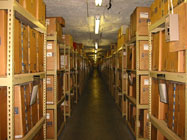
Photo date 10/05, © S.W. Aber. |
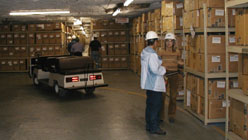
Photo date 10/05, © Photo courtesy of Marcia Schulmeister. |
|
The Underground Vaults and Storage is a company that employs 120 people and has other storage facilities in Kentucky, Oklahoma, Kansas, and Missouri (Lee Spence, personal communication, October 28, 2005). While 70 people work underground in storage centers, there are only 15 miners at Carey Salt who are drillers, undercutters, explosive experts, etc (Spence). This classic room-and-pillar mining method creates open caverns that are held up with salt left in place in the form of pillars. Room-and-pillar sizes vary with mining practices. There are 50 foot pillars and 40 foot pillars in some rooms, while other rooms in newer mined areas have 20 foot pillars and one 300 foot pillar in the center of the room (Spence). Corridors and rooms have rock salt floors, walls, and ceiling, but in the storage areas the salt is painted or cemented. The paint brightens up the space, while the cement creates a flat surface for storage shelves. All of the concrete is mixed on-site, that is underground using salt in the aggregate mix instead of sand hauled from the surface! |
||
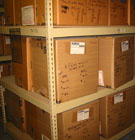
Photo date 10/05, © S.W. Aber. |
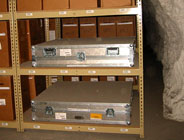
Photo date 10/05, © S.W. Aber. |
|
This facility has a 15,000 square feet storage bay and approximately 6 million boxes stacked on the many miles of shelving. The company provides the boxes and each box rents for $1.80 per year. Some boxes may contain family archives such as a wedding dress, while other boxes may contain company secret recipes or everyday business records. Boxes and shelf space is rented by film companies for the television and movie originals. The larger the container, the larger the film format. The image on the right contains film used in IMAX movie theaters. The facility is perfect for storing a variety of artifacts because of the stable year-round temperature of 68 degrees Fahrenheit and constant 42% humidity conditions. Also, it is a secure location. Stored items can be retrieved with notice or shredded and destroyed. For specific information visit the Underground Vaults and Storage website at www.undergroundvaults.com. |
||
 For information about hydrogeology and environmental geology at ESU, visit webpages by Marcia Schulmeister at http://hydrogeology.emporia.edu/, and for specific information regarding the ES 333 field trip see, http://hydrogeology.emporia.edu/Saltminefieldtrip2003.html.
For information about hydrogeology and environmental geology at ESU, visit webpages by Marcia Schulmeister at http://hydrogeology.emporia.edu/, and for specific information regarding the ES 333 field trip see, http://hydrogeology.emporia.edu/Saltminefieldtrip2003.html.
Return to The Many Uses of Salt from the Earth.
Acknowledgements: I want to thank Dr. Marcia Schulmeister and Kevin Barnett for providing images. Also, I want to acknowledge Dr. Marcia Schulmeister for her help in proof-reading and text suggestions.© Notice: The Many Uses of Salt from the Earth Salt Mining and Storage Caverns webpage was created for educational purposes and while everyone is welcome to view these webpages, any use or repackaging of these materials is prohibited without permission from the author, Dr. Susan W. Aber, abersusa@emporia.edu. Dr. Aber teaches at Emporia State University, www.emporia.edu/earthsci/abersusa.htm. This webpage was created November 28, 2005; last update May 30, 2007.